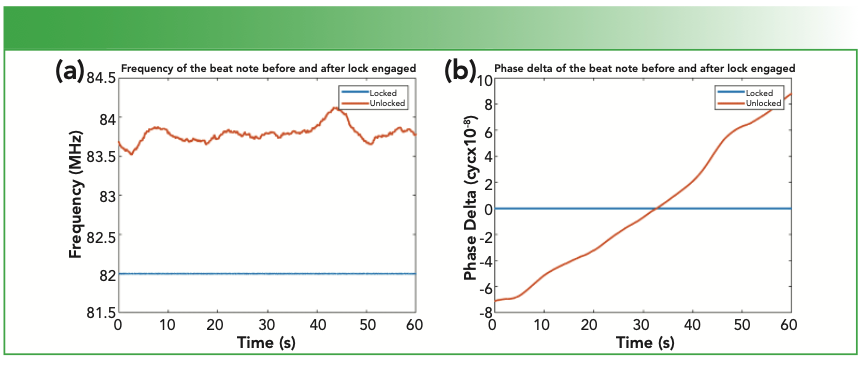Laser Frequency Offset Locking
Sponsored Content
Optical phase-locking is a common technique for transferring the frequency and phase characteristics of one laser beam to another. It is commonly used in heterodyne metrology, free-space optical communications, and spectroscopic applications. In this technical note we discuss the implementation of offset phase locking using a digital phasemeter and characterize the stability of phase locking two lasers.
Optical Offset Phase Locking
To put it simply, offset phase locking stabilizes phase difference between two lasers. This is done by a relatively simple process combining the outputs of the two lasers (via a beamsplitter or similar) and illuminating a photodetector with the combined beam. The combined power on the photodetector PPD can be described by:

Where ω1 and ω2 denote the frequency, and φ1 and φ2 denote the phase of each laser. Note that the high order terms are generally outside the bandwidth of the photodetectors. It is important to recognize that even though the beat note contains phase information of the lasers, this information is contained in the argument of the signal and is relatively difficult to use in feedback systems in this form. To extract the phase from the beat note we use a phase detector.
Moku:Pro Phasemeter
Although a mixer and low pass filter are adequate for most offset phase locking system, they are not without their limitations. For one, the range of the mixer-filter combination is limited to ±π/2, and the phase output from the system is linear only when very close to zero. These range and linearity issues often make it difficult to deal with systems with large fluctuations. Moku:Pro Phasemeter uses phase-locked loops (PLL) as the phase detectors, and provides automatic phase unwrap function to extend the linear dynamic range of a standard mixer-type phase detector. The PLL can assist in initial lock acquisition, removal of nonlinear affects (such as cycle slipping), and ensure a more robust lock.
Experimental Setup
We demonstrated Moku:Pro's Phasemeter offset phase locking architecture using two nonplanar ring oscillators (NPRO) lasers. The beams of the master and slave lasers were combined by a beamsplitter and interfered at a photodiode as shown in Figure 1. The beat note was connected to Moku:Pro's input 1. The feedback signal was then connected to the frequency controller of the following laser.
Figure 1: Instrument setup for offset locking.

Lock Performance
To evaluate the phase stability of the lock, an additional Moku:Lab Phasemeter was connected to the photodetector to capture the frequency and phase drift as a function of time. Taking the amplitude spectral density of the frequency, we see that an improvement in the stability of over 4 orders of magnitude was measured, with relative frequency stability of 1 Hz/√Hz measured down to 0.1 Hz.
Figure 2: Frequency (a) and phase (b) of the offset beat note locked and unlocked.

Questions?
Liquid Instruments
740 Lomas Santa Fe Dr Ste 102, Solana Beach, CA 92075
Tel. (619)-332-6230
Website: www.liquidinstruments.com
